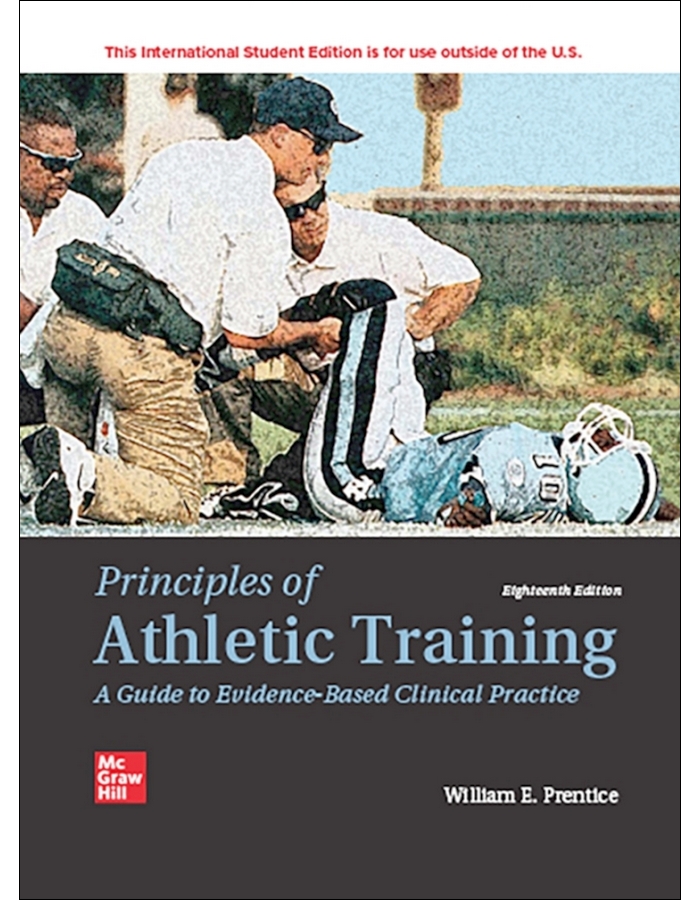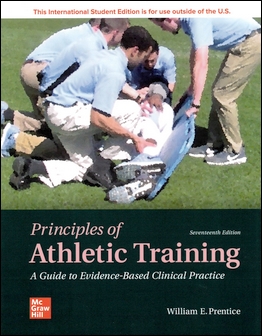(eBook) Principles of Athletic Training: A Guide to Evidence-Based Clinical Practice 18/e
- ◉ VitalSource◉ 閱讀期限:Lifetime
售價
$
1,000
- 電子書
- ISBN:9781266758850
- 作者:William Prentice
- 版次:18
- 年份:2024
- 出版商:McGraw-Hill
- 頁數/規格:電子書
書籍介紹
目錄
►VitalSource 電子書購買須知:
Description
Principles of Athletic Training: A Guide to Evidence-Based Clinical Practice is designed to educate athletic trainers in courses concerned with the scientific, evidence-based, clinical foundations of athletic training and sports medicine. The goal is to help students become competent health care professionals who will continue to advance the athletic training profession. The text leads students from general foundations to specific concepts related to injury prevention, evaluation, management, and rehabilitation. Students will explore the complexities of the profession of athletic training. An overarching goal is to incorporate the best available evidence to support recommendations for patient care. The 18th edition includes more than 850 instructional videos demonstrating injury evaluation skills, clinical techniques, and rehab exercises, all conveniently accessed through the eBook.
- 閱讀期限:Lifetime
- 電子書兌換碼將於 3-5 個工作天,寄送至「序號寄送 E-mail」所填寫的信箱。
- 根據消費者保護法第 19 條第 1 項規定,本產品為數位內容,售出後恕不接受退貨或退款。
- 本產品僅限台灣境內使用,海外 IP 無法註冊或啟用。
- 電子書平台登錄與註冊說明 (eText-Register.pdf)。
- 電子書平台操作手冊 (eText-Manual.pdf)。
- 如有任何問題,請 Email 至 ebook@tunghua.com.tw。
Description
Principles of Athletic Training: A Guide to Evidence-Based Clinical Practice is designed to educate athletic trainers in courses concerned with the scientific, evidence-based, clinical foundations of athletic training and sports medicine. The goal is to help students become competent health care professionals who will continue to advance the athletic training profession. The text leads students from general foundations to specific concepts related to injury prevention, evaluation, management, and rehabilitation. Students will explore the complexities of the profession of athletic training. An overarching goal is to incorporate the best available evidence to support recommendations for patient care. The 18th edition includes more than 850 instructional videos demonstrating injury evaluation skills, clinical techniques, and rehab exercises, all conveniently accessed through the eBook.
Table of Contents
PREFACE
APPLICATIONS AT A GLANCE
PART I PROFESSIONAL DEVELOPMENT AND RESPONSIBILITIES
Chapter 1 The Athletic Trainer as a Health Care Provider
Chapter 2 Health Care Organization and Administration in Athletic Training
Chapter 3 Legal Concerns, Insurance, and Third-Party Reimbursement
PART II RISK MANAGEMENT
Chapter 4 Fitness and Conditioning Techniques
Chapter 5 Nutrition and Supplements
Chapter 6 Environmental Considerations
Chapter 7 Selection and Fitting of Protective Equipment
Chapter 8 Wrapping and Taping
PART III PATHOLOGY OF SPORTS INJURY
Chapter 9 Mechanisms and Characteristics of Musculoskeletal and Nerve Trauma
Chapter 10 Tissue Response to Injury
PART IV MANAGEMENT SKILLS
Chapter 11 Psychosocial Intervention for Sports Injuries and Illnesses
Chapter 12 On-the-Field Acute Care and Emergency Procedures
Chapter 13 Off-the-Field Injury Evaluation
Chapter 14 Infectious Diseases, Bloodborne Pathogens, and Standard Precautions
Chapter 15 Using Therapeutic Modalities
Chapter 16 Using Therapeutic Exercise in Rehabilitation
Chapter 17 Pharmacology, Drugs, and Sports
PART V MUSCULOSKELETAL CONDITIONS
Chapter 18 The Foot
Chapter 19 The Ankle and Lower Leg
Chapter 20 The Knee and Related Structures
Chapter 21 The Thigh, Hip, Groin, and Pelvis
Chapter 22 The Shoulder Complex
Chapter 23 The Elbow
Chapter 24 The Forearm, Wrist, Hand, and Fingers
Chapter 25 The Spine
PART VI GENERAL MEDICAL CONDITIONS
Chapter 26 The Head, Face, Eyes, Ears, Nose, and Throat
Chapter 27 The Thorax and Abdomen
Chapter 28 Skin Disorders
Chapter 29 Additional General Medical Conditions
APPENDIXES
Appendix A Addresses of Professional Sports Medicine Organizations
Appendix B NATA Position, Official, Consensus, and Support Statements
Appendix C Sports Medicine–Related Journals
Appendix D The Process Leading to CAATE Accreditation of the Athletic Trainer as an Allied Health Care Professional
Appendix E Sample Résumé
Appendix F NATA Code of Ethics
Appendix G Code of Professional Responsibility
Appendix H Manual Muscle Tests
Appendix I Goniometric Measurements of Range of Motion
Appendix J Vestibular/Ocular-Motor Screening (VOMS) for Concussion
GLOSSARY
INDEX
SUGGESTED SUPPLIES
PREFACE
APPLICATIONS AT A GLANCE
PART I PROFESSIONAL DEVELOPMENT AND RESPONSIBILITIES
Chapter 1 The Athletic Trainer as a Health Care Provider
Chapter 2 Health Care Organization and Administration in Athletic Training
Chapter 3 Legal Concerns, Insurance, and Third-Party Reimbursement
PART II RISK MANAGEMENT
Chapter 4 Fitness and Conditioning Techniques
Chapter 5 Nutrition and Supplements
Chapter 6 Environmental Considerations
Chapter 7 Selection and Fitting of Protective Equipment
Chapter 8 Wrapping and Taping
PART III PATHOLOGY OF SPORTS INJURY
Chapter 9 Mechanisms and Characteristics of Musculoskeletal and Nerve Trauma
Chapter 10 Tissue Response to Injury
PART IV MANAGEMENT SKILLS
Chapter 11 Psychosocial Intervention for Sports Injuries and Illnesses
Chapter 12 On-the-Field Acute Care and Emergency Procedures
Chapter 13 Off-the-Field Injury Evaluation
Chapter 14 Infectious Diseases, Bloodborne Pathogens, and Standard Precautions
Chapter 15 Using Therapeutic Modalities
Chapter 16 Using Therapeutic Exercise in Rehabilitation
Chapter 17 Pharmacology, Drugs, and Sports
PART V MUSCULOSKELETAL CONDITIONS
Chapter 18 The Foot
Chapter 19 The Ankle and Lower Leg
Chapter 20 The Knee and Related Structures
Chapter 21 The Thigh, Hip, Groin, and Pelvis
Chapter 22 The Shoulder Complex
Chapter 23 The Elbow
Chapter 24 The Forearm, Wrist, Hand, and Fingers
Chapter 25 The Spine
PART VI GENERAL MEDICAL CONDITIONS
Chapter 26 The Head, Face, Eyes, Ears, Nose, and Throat
Chapter 27 The Thorax and Abdomen
Chapter 28 Skin Disorders
Chapter 29 Additional General Medical Conditions
APPENDIXES
Appendix A Addresses of Professional Sports Medicine Organizations
Appendix B NATA Position, Official, Consensus, and Support Statements
Appendix C Sports Medicine–Related Journals
Appendix D The Process Leading to CAATE Accreditation of the Athletic Trainer as an Allied Health Care Professional
Appendix E Sample Résumé
Appendix F NATA Code of Ethics
Appendix G Code of Professional Responsibility
Appendix H Manual Muscle Tests
Appendix I Goniometric Measurements of Range of Motion
Appendix J Vestibular/Ocular-Motor Screening (VOMS) for Concussion
GLOSSARY
INDEX
SUGGESTED SUPPLIES


